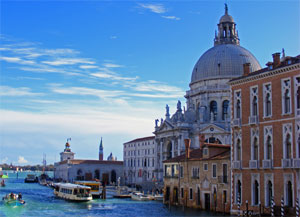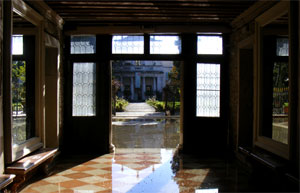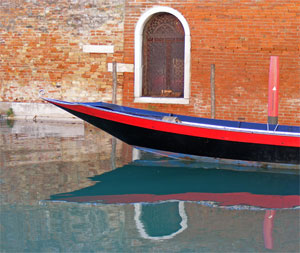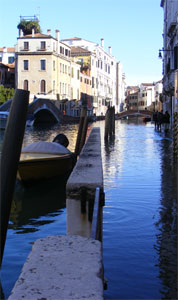
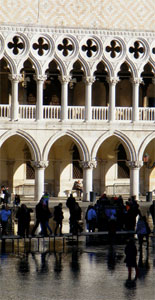
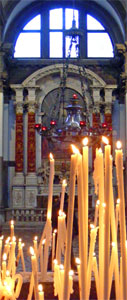
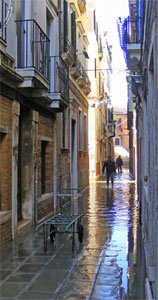
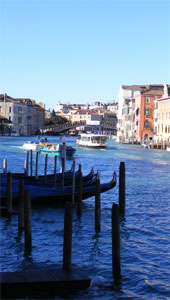
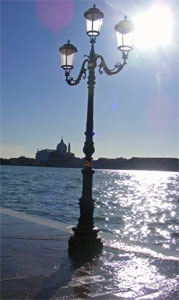
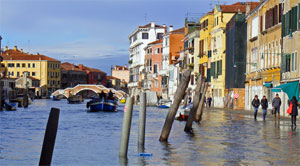
22 November 2013
What a very strange autumn this is. In early October, we froze in driving rain in Ferrara. On November 22 we sat out on the Grand Canal-side terrace of the Gritti Palace in Venice, sunglasses firmly on as we ate our breakfast basking in warm sunlight dazzling off white tablecloths.
I was in Venice for work – guide updating, not garden-making alas – and was bracing for damp cold days. But the forecasters couldn’t have been more wrong. Acqua alta there was – and for three of my four days it was significantly high – but for most of the time the skies were clear and the city’s colours were gem-like and brilliant. I stayed in two of my favourite smaller Venetian hotels – Oltre il Giardino and Palazzo Abadessa: the former cool hues and modern-classic; the latter tasteful, warm Venetian plush and spectacular old parquet, both with lovely gardens – before L joined me and we moved to the Gritti. The Gritti is definitely less dreary feeling after its recent total revamp (last time we were there was on a hard-hat visit) and the great swathes of gorgeous Rubelli fabrics and painstaking restoration of all the details really do impress But I still find it stuffy, somehow, and rather full of itself… though perhaps you just have to accept that from such a venerable Venetian monument.
At the Gritti we were guests of the Alajmo brothers, who were launching their latest book, Fluidità (at a very swish party in the library of the Biennale inside the Giardini for which I was rather unprepared and under-dressed). Massimiliano Alajmo is a great chef… not that we’ve ever been to his main place, Le Calandre, but his Venetian restaurant in the Caffè Quadri deserves its Michelin star: this is one of those ‘top’ restaurants where there’s substance behind the brouhaha.
So sweetly smiling and seemingly reserved is Massimiliano that his books – like his presentation of the new title last night – come as a surprise: there are moments when he, and it, slither into new-age babble of the loftily meaningless pretentious stamp. And the book tips slightly too much into the artsy-decorative with its photos of food shot through water: striking at first but after a while Cynical Me would just like to be able to see the dishes properly (the accompanying ‘making-of’ black-and-white images are beautiful, on the other hand).
Just as well there was the food (and the alcohol – endless streams of exquisite bubblies) to ground the event again. You can forgive even the meat served in syringes or in huge hollowed-out pork shin bones and the cocoa-butter sweets shaped into lipsticks when what you’re eating is this good. And being fed once again today at the Caffè Quadri just drove the point home: raw prawns that dissolve in your mouth like mildly resisting gelatine, a deceptively simple cream of pale (haricot?) beans with bottarga (dried pressed fish roe) grated on top, a paper bag of fish fried so lightly that even I – who dislikes fried food intensely – ate far too much of it. Very good indeed.
Before this dip into mondanity, I had been plodding – often wading – through Venice’s streets in search of the novel and exciting. On the food front, things seemed to be largely the same: nothing must-do new (with the possible exception of Il CoVino but its two closing days meant I never made it there).
But I enjoyed my visit to the newly reopened Palazzo Mocenigo. I always rather liked this dusty, moth-holey receptacle for a few old costumes and some patchy furniture. Now the dust and moths have been banished, the costumes are beautifully displayed and well lit, the furniture has been given a brush-up, the walls have been clad in Rubelli fabrics (are there any walls in Venice which haven’t? This very Venetian firm is everywhere), and a few rooms dedicated to the history and methods of perfumery have been added, complete with bottles and boxes to sniff and explore The effect is totally charming: this is my new favourite small Venetian museum – vying for my affection with the Cini gallery in Dorsoduro which we went into this morning. There’s a Lorenzo Lotto double portrait in there which I could lose myself in front of. The Biennale is in its final days but the Cini is still hosting the Angolan exhibition: there are piles of prints of rather wonderful photographs by an Angolan photographer whose name escapes me lying about on palettes on the floor, their muted earth colours contrasting strikingly with the dark varnish and stark portraiture of the Cini collection.
(The Biennale let me into another venue whose front door I have stared at many times but never been able to get through: Ca’ Zenobio, the Armenian college. This time, though, it was hosting the Icelandic pavilion: some powreful photos and an installation involving black and white tiles in buildings out the back of the utterly wonderful, totally unkempt garden, through an entrance hall which was awash when I turned up. The Biennale is a fantastic thing in many ways, but the opportunity for getting into locked-up places is definitely one of its main attractions for me.)
Another Venetian novelty is the Scuola di San Marco, aka the Ospedale Civile. It still functions as the main city hospital; there are still little old ladies being pushed about in wheelchairs for their constitutionals and nursing staff having a furtive cigarette break in the campo outside. But the magnificent entrance and the vast room above it have been restored. Upstairs, old display cases hold historic medical treatises and implements, and huge tomes containing centuries of hospital records written in spidery script: so many unmarried servant girls brought in to pass the final three months of their pregnancies here, presumably to prevent too much embarrassment for the employers who got them into that state; and the numbers of patients brought in as ‘mental cases’ – almost as many as those suffering diseases or needing surgery.
We were there, by chance, for the pre-opening of the restored rooms, on the festa della Salute (November 21). The place was open to all, with a concert by the philharmonic orchestra of La Fenice. Magnificent. From next Monday, these rooms become another of the city’s tourist attractions.
